

Return 0 when input exceeds buffer space. Return EOF on input error or end-of-file with no input. One modest approach using fgets(): // Return 1 on success. Processes are divided into three regions: Text, Data, and Stack. Process Memory Organization To understand what stack buffers are we must first understand how a process is organized in memory. To robustly read a line in C, unfortunately, is not easy and a real good way is beyond a beginner's need. We will concern ourselves only with the overflow of dynamic buffers, otherwise known as stackbased buffer overflows.
#BUFFER OVERFLOW STACK CODE#
Other answers have well addressed why OP's code is performing as it is.

until the next character is a newline or we hit the end-of-file) The * indicates that the newly-read value should not be stored anywhere, and the indicates that zero or more non-newline characters should be read, until the pattern doesn't match anymore (i.e. In C++, there's a function called std::getline that will do it for you, but in C, you'll need to manually read (and discard) the rest of the line yourself. If you want to do that, then you need to handle delimiters yourself. Stack Canaries One of the most important buffer overflow attacks is the first Internet worm, written by Robert Morris Jr. You never said "from three different lines". In version 2023.01 and prior, an attacker can send a crafted frame to the device resulting in an out of bounds write in the packet buffer. I have a question of why a particular buffer overflow is not working with strcpy (). You asked it to read from the input buffer three times. Description RIOT-OS, an operating system for Internet of Things (IoT) devices, contains a network stack with the ability to process 6LoWPAN frames. 1 Practicing and learning buffer overflows by example. The program is well-defined and does what you asked it to. There is no buffer overflow vulnerability here. Now all of our inputs have been completed, so the program continues. No need to interactively wait for input anymore C takes the first 100 of those characters and puts them into the third variable, terminated with a null terminator. Therefore, there are still 144 characters in the input buffer. We put 160 characters into the input buffer (your keyboard smash) and took 14 out. Specifically, we need to get the next 100 characters, or all of the characters up to the next whitespace, whichever is shorter. Now we need to get data for the third variable. It terminates this with a null terminator.

Ignoring the first variable for now (since there's no overflow), C takes the first 14 characters from the input buffer and puts them in the second variable. The first one has a maximum length of 200 characters, the second 14, and the third 100.


 0 kommentar(er)
0 kommentar(er)
